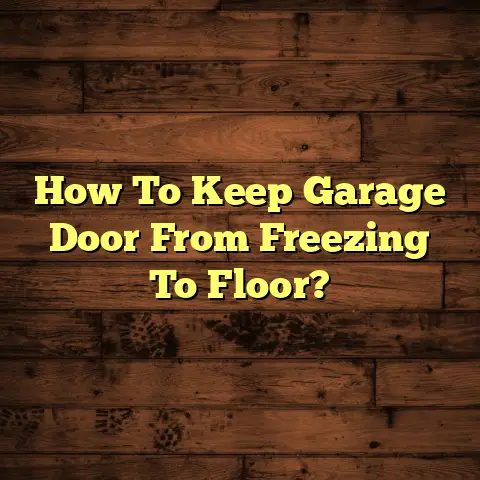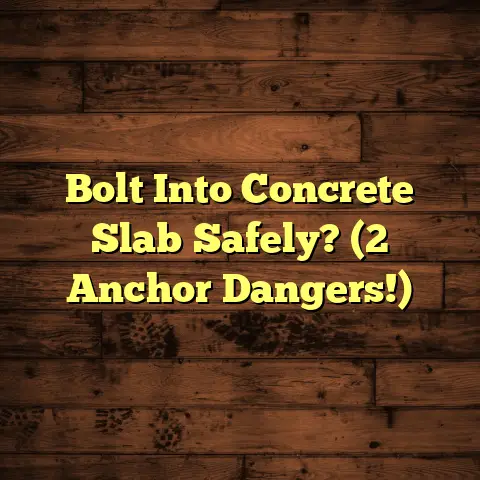Garage Floor Pitting: Quick Repair Tips? (7 Fixes!)
Your garage floor is a battleground, enduring the weight of your car, the intrusion of moisture, and the relentless assault of time.
Yet, you might be ignoring a silent enemy: pitting.
I’ve seen countless garages where small pits have turned into major problems.
It’s not just about aesthetics; it’s about safety and the long-term health of your garage.
Garage floor pitting isn’t just an eyesore; it’s a sign of underlying issues that, if left unchecked, can lead to significant structural damage.
Imagine tripping over a crumbling pit while carrying heavy tools, or the slow, insidious damage that moisture trapped in these pits can inflict on your foundation.
That’s why addressing pitting quickly is essential, not just for maintaining appearance but also for preserving the integrity of the entire garage space.
Think of your garage floor as an investment, and these quick fixes as preventative maintenance.
Let’s dive in and explore how to tackle those pesky pits before they become a real headache!
Section 1: Understanding Garage Floor Pitting
What is Garage Floor Pitting?
Garage floor pitting is the formation of small, irregular holes or depressions on the surface of your garage floor.
These pits can range in size from tiny pinholes to larger, more noticeable craters.
What causes them?
-
Moisture: Water seeping into the concrete and causing it to erode over time.
-
Chemical Spills: Road salts, oil, and other chemicals can react with the concrete, leading to breakdown.
-
Wear and Tear: Simply driving and parking your car can gradually wear down the surface.
-
Freeze-Thaw Cycles: Water expands when it freezes, exerting pressure on the concrete and causing it to crack and pit.
Common Garage Floor Materials and Pitting
Most garage floors are made of concrete, but you’ll also find epoxy-coated floors.
Here’s how pitting affects each:
-
Concrete: Concrete is porous, making it vulnerable to moisture and chemical damage. Pitting in concrete is often caused by the factors listed above.
-
Epoxy: Epoxy coatings provide a protective layer, but they’re not invincible. If the epoxy is improperly applied or damaged, moisture can get underneath and cause pitting in the concrete below.
I’ve seen cases where people skipped the proper surface prep before applying epoxy, leading to premature failure and pitting.
Consequences of Neglecting Pitting
Ignoring garage floor pitting can lead to a cascade of problems:
-
Structural Damage: Pits can weaken the concrete, leading to cracks and further deterioration.
-
Safety Issues: Pits create tripping hazards and can damage your car’s tires.
-
Increased Repair Costs: Small pits are easy to fix, but if left unchecked, they can require more extensive and expensive repairs down the road.
I remember one client who ignored a few small pits for years. Eventually, the entire floor needed to be replaced!
-
Aesthetic Degradation: Let’s face it, a pitted garage floor just looks bad. It detracts from the overall appearance of your home.
Section 2: Quick Fix #1: Cleaning and Preparation
Before you even think about patching or coating, you need to clean the area.
Trust me, skipping this step is like building a house on sand.
The Importance of Thorough Cleaning
Cleaning removes dirt, oil, and debris that can prevent your repair materials from bonding properly.
A clean surface ensures a strong, durable repair.
Tools and Materials Needed
- Broom
- Vacuum
- Pressure Washer (optional, but highly recommended)
- Concrete Cleaner or Degreaser
- Scrub Brush
- Shop Rags
Step-by-Step Cleaning Guide
-
Sweep and Vacuum: Remove loose debris, leaves, and dirt with a broom and vacuum.
-
Apply Concrete Cleaner: Use a concrete cleaner or degreaser to remove oil stains and grime. Follow the manufacturer’s instructions.
I’ve found that a citrus-based cleaner works wonders on grease stains.
-
Scrub the Pitted Areas: Use a scrub brush to thoroughly clean the pitted areas. Pay special attention to removing any loose concrete or debris.
-
Rinse with Water: Rinse the floor thoroughly with water.
-
Pressure Wash (Optional): A pressure washer can be used to blast away stubborn dirt and grime. Be careful not to damage the concrete.
If you’re using a pressure washer, start with a low pressure setting and gradually increase it as needed.
-
Dry the Floor: Allow the floor to dry completely before proceeding with any repairs. This may take several hours or even overnight.
I usually use a fan to speed up the drying process.
Section 3: Quick Fix #2: Concrete Patch Compound
Concrete patch compound is your go-to for filling those pesky pits.
It’s relatively inexpensive and easy to use, making it a great option for DIYers.
Choosing the Right Product
Look for a concrete patch compound that is specifically designed for repairing concrete floors.
Consider these factors:
-
Strength: Choose a compound that is strong enough to withstand the weight of your car and other heavy objects.
-
Durability: Look for a compound that is resistant to moisture, chemicals, and abrasion.
-
Cure Time: Consider the cure time of the compound. Some compounds cure quickly, while others take longer.
Application Process
-
Prepare the Patch Compound: Mix the concrete patch compound according to the manufacturer’s instructions. Be sure to add the correct amount of water to achieve the desired consistency.
I always mix a small batch first to make sure I have the right consistency.
-
Apply the Compound: Use a trowel or putty knife to apply the compound to the pitted areas. Overfill the pits slightly to allow for shrinkage.
-
Smooth the Surface: Use a trowel to smooth the surface of the compound. Feather the edges to blend the patch with the surrounding concrete.
-
Allow to Cure: Allow the compound to cure according to the manufacturer’s instructions. This may take several hours or even days.
Drying Times and Finishing
-
Drying Time: Drying times vary depending on the product and the environmental conditions. Generally, it takes at least 24 hours for the compound to dry completely.
-
Finishing: Once the compound is dry, you can sand it smooth with a sanding block or grinder. You can also apply a concrete sealer to protect the patch and blend it with the surrounding concrete.
I like to use a concrete sealer with a matte finish to avoid a glossy look.
Section 4: Quick Fix #3: Epoxy Coating
Epoxy coatings are a fantastic way to not only repair pitting but also provide a durable, protective layer for your garage floor.
Benefits of Epoxy Coating
-
Durability: Epoxy coatings are highly resistant to moisture, chemicals, and abrasion.
-
Aesthetics: Epoxy coatings come in a variety of colors and finishes, allowing you to customize the look of your garage floor.
-
Easy to Clean: Epoxy coatings are easy to clean and maintain.
Preparation, Mixing, and Application
-
Prepare the Surface: Clean the floor thoroughly using the steps outlined in Section 2. You may also need to etch the concrete with muriatic acid to improve adhesion.
Always wear appropriate safety gear when working with muriatic acid.
-
Mix the Epoxy: Mix the epoxy according to the manufacturer’s instructions. Be sure to use the correct ratio of resin to hardener.
-
Apply the Epoxy: Use a roller or brush to apply the epoxy to the floor. Apply a thin, even coat.
-
Add Decorative Flakes (Optional): If desired, you can add decorative flakes to the epoxy while it is still wet.
-
Apply a Second Coat: Apply a second coat of epoxy after the first coat has dried.
Tips for a Professional Finish
-
Work in a Well-Ventilated Area: Epoxy fumes can be strong, so be sure to work in a well-ventilated area.
-
Use a Self-Leveling Epoxy: A self-leveling epoxy will help to create a smooth, even finish.
-
Avoid Applying Epoxy in Direct Sunlight: Direct sunlight can cause the epoxy to cure too quickly, leading to bubbles and other imperfections.
-
Follow the Manufacturer’s Instructions: Always follow the manufacturer’s instructions for mixing and application.
Section 5: Quick Fix #4: Floor Resurfacer
Floor resurfacer is a great option for more extensive pitting or when you want to give your entire garage floor a fresh, new look.
Benefits of Floor Resurfacer
-
Covers Extensive Damage: Floor resurfacer can cover larger areas of pitting and cracking.
-
Creates a Smooth, Even Surface: Floor resurfacer creates a smooth, even surface that is ideal for epoxy coatings or other finishes.
-
Improves the Appearance of Your Garage Floor: Floor resurfacer can dramatically improve the appearance of your garage floor.
Application Guide
-
Prepare the Surface: Clean the floor thoroughly using the steps outlined in Section 2. You may also need to grind the concrete to create a rough surface for better adhesion.
-
Mix the Resurfacer: Mix the floor resurfacer according to the manufacturer’s instructions. Be sure to add the correct amount of water to achieve the desired consistency.
-
Apply the Resurfacer: Use a trowel or squeegee to apply the resurfacer to the floor. Apply a thin, even coat.
-
Allow to Cure: Allow the resurfacer to cure according to the manufacturer’s instructions. This may take several days.
-
Sand the Surface: Once the resurfacer is dry, you can sand it smooth with a sanding block or grinder.
-
Apply a Sealer or Coating: Apply a concrete sealer or epoxy coating to protect the resurfacer and improve its appearance.
Section 6: Quick Fix #5: Using a Concrete Grinder
A concrete grinder is a powerful tool that can be used to level out pitted areas, especially if the pitting is extensive.
Benefits of Using a Concrete Grinder
-
Levels Out Uneven Surfaces: A concrete grinder can level out uneven surfaces caused by pitting and cracking.
-
Prepares the Surface for Coatings: A concrete grinder can prepare the surface for epoxy coatings or other finishes.
-
Removes Old Coatings: A concrete grinder can remove old epoxy coatings or other finishes.
Safety Tips
-
Wear Safety Glasses: Always wear safety glasses to protect your eyes from flying debris.
-
Wear a Dust Mask: Always wear a dust mask to protect your lungs from concrete dust.
-
Wear Hearing Protection: Concrete grinders can be loud, so wear hearing protection to prevent hearing damage.
-
Use a Vacuum System: Use a vacuum system to collect concrete dust and keep the work area clean.
Step-by-Step Grinding Guide
-
Prepare the Surface: Clean the floor thoroughly using the steps outlined in Section 2.
-
Choose the Right Grinding Disc: Choose a grinding disc that is appropriate for the type of concrete and the amount of pitting.
-
Grind the Surface: Use the concrete grinder to grind the surface of the floor. Start with a coarse grit disc and gradually move to a finer grit disc.
-
Vacuum the Dust: Vacuum the concrete dust regularly to keep the work area clean.
-
Inspect the Surface: Inspect the surface to make sure it is level and smooth.
Section 7: Quick Fix #6: Pouring New Concrete
When pitting is severe and widespread, pouring new concrete may be the best solution.
This is a more involved process, but it can provide a long-lasting, durable repair.
When to Consider New Concrete
-
Extensive Pitting: When pitting covers a large portion of the floor.
-
Structural Damage: When the concrete is severely cracked or damaged.
-
Uneven Surface: When the floor is significantly uneven due to pitting.
Preparation Required
-
Remove Old Concrete: Remove the old concrete using a jackhammer or other demolition tools.
-
Prepare the Subgrade: Prepare the subgrade by compacting the soil and adding a layer of gravel.
-
Install Reinforcement: Install reinforcement, such as rebar or wire mesh, to strengthen the new concrete.
-
Build Forms: Build forms to contain the new concrete.
Mixing, Pouring, and Finishing
-
Mix the Concrete: Mix the concrete according to the manufacturer’s instructions.
-
Pour the Concrete: Pour the concrete into the forms.
-
Screed the Concrete: Screed the concrete to create a level surface.
-
Float the Concrete: Float the concrete to smooth the surface and remove any imperfections.
-
Trowel the Concrete: Trowel the concrete to create a smooth, hard finish.
-
Cure the Concrete: Cure the concrete by keeping it moist for several days.
Section 8: Quick Fix #7: Preventive Measures
Preventing pitting is always better than fixing it.
Here are some preventive measures you can take to protect your garage floor:
Sealants and Regular Maintenance
-
Apply a Concrete Sealer: Apply a concrete sealer every few years to protect the concrete from moisture and chemicals.
-
Clean Up Spills Immediately: Clean up spills immediately to prevent them from damaging the concrete.
-
Sweep Regularly: Sweep the floor regularly to remove dirt and debris.
Drainage and Moisture Control
-
Ensure Proper Drainage: Make sure your garage has proper drainage to prevent water from pooling on the floor.
-
Control Moisture: Control moisture by using a dehumidifier or by improving ventilation.
-
Use Floor Mats: Use floor mats to protect the concrete from wear and tear.
Conclusion
Garage floor pitting is a common problem, but it doesn’t have to be a major headache.
By understanding the causes of pitting and taking prompt action, you can restore the functionality and appearance of your garage floor.
While these quick fixes can provide effective solutions, ongoing maintenance is crucial for long-term health.
Regular cleaning, sealing, and moisture control can help prevent pitting from recurring and keep your garage floor looking its best for years to come.
So, take charge of your garage floor’s health today!
Implement these fixes, and enjoy a safer, more attractive, and longer-lasting garage space.





